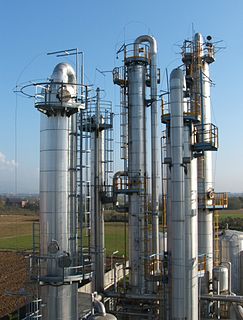
Ammonia is a compound of nitrogen and hydrogen with the formula NH3. A stable binary hydride, and the simplest pnictogen hydride, ammonia is a colourless gas with a characteristic pungent smell. It is a common nitrogenous waste, particularly among aquatic organisms, and it contributes significantly to the nutritional needs of terrestrial organisms by serving as a precursor to food and fertilizers. Ammonia, either directly or indirectly, is also a building block for the synthesis of many pharmaceutical products and is used in many commercial cleaning products. It is mainly collected by downward displacement of both air and water. Ammonia is named for the Ammonians, worshipers of the Egyptian god Amun, who used ammonium chloride in their rituals.

Hydrazine is an inorganic compound with the chemical formula N
2H
4. It is a simple pnictogen hydride, and is a colorless and flammable liquid with an ammonia-like odor.
Unsymmetrical dimethylhydrazine (UDMH; 1,1-dimethylhydrazine) is a chemical compound with the formula H2NN(CH3)2. It is a colorless liquid, with a sharp, fishy, ammonia-like smell typical for organic amines. Samples turn yellowish on exposure to air and absorb oxygen and carbon dioxide. It mixes completely with water, ethanol, and kerosene. In concentration between 2.5% and 95% in air, its vapors are flammable. It is not sensitive to shock. 1,2-Dimethylhydrazine (CH3NHNHCH3) is also known but is not as useful.
The cumene process is an industrial process for synthesizing phenol and acetone from benzene and propylene. The term stems from cumene, the intermediate material during the process. It was invented by R. Ūdris and P. Sergeyev in 1942 (USSR)., and independently by Heinrich Hock in 1944

Raschig rings are pieces of tube, approximately equal in length and diameter, used in large numbers as a packed bed within columns for distillations and other chemical engineering processes. They are usually ceramic or metal and provide a large surface area within the volume of the column for interaction between liquid and gas vapours. Raschig rings are named after their inventor, German chemist Friedrich Raschig.

A fractionating column is an essential item used in distillation of liquid mixtures so as to separate the mixture into its component parts, or fractions, based on the differences in volatilities. Fractionating columns are used in small scale laboratory distillations as well as for large scale industrial distillations.

Industrial processes are procedures involving chemical, physical, electrical or mechanical steps to aid in the manufacturing of an item or items, usually carried out on a very large scale. Industrial processes are the key components of heavy industry.
The peroxide process is a method for the industrial production of hydrazine.

Continuous distillation, a form of distillation, is an ongoing separation in which a mixture is continuously fed into the process and separated fractions are removed continuously as output streams. Distillation is the separation or partial separation of a liquid feed mixture into components or fractions by selective boiling and condensation. The process produces at least two output fractions. These fractions include at least one volatile distillate fraction, which has boiled and been separately captured as a vapor condensed to a liquid, and practically always a bottoms fraction, which is the least volatile residue that has not been separately captured as a condensed vapor.

The Threepenny Opera is a 1931 German musical film directed by G. W. Pabst. It was produced by Seymour Nebenzal's Nero-Film for Tonbild-Syndikat AG (Tobis), Berlin and Warner Bros. Pictures GmbH, Berlin. The film is loosely based on the 1928 musical theatre success The Threepenny Opera by Bertolt Brecht and Kurt Weill. As was usual in the early sound film era, Pabst also directed a French language version of the film, L'Opéra de quat'sous, with some variation of plot details. A planned English version was not made. The two existing versions were released by The Criterion Collection on home video.

Friedrich August Raschig was a German chemist and politician. He was born in Brandenburg an der Havel. After he received his PhD in 1884 from the University of Berlin for his work with Robert Wilhelm Bunsen, he started working at the BASF company. In 1891 he opened his own chemical company in Ludwigshafen am Rhein. He patented a number of chemical processes, particularly relating to phenols, one of which is now known as the Raschig phenol process, and nitrogen compounds—the Raschig process for producing hydroxylamine and the Olin Raschig process for producing hydrazine. He also developed improvements to distillation, in particular the Raschig ring, small metal or ceramic rings which are used in commercial fractional distillation columns.

Chlorine azide (ClN3) is an inorganic compound that was discovered in 1908 by Friedrich Raschig. Concentrated ClN
3 is notoriously unstable and may spontaneously detonate at any temperature.
Trust of Thieves is a 1929 German silent film directed by Erich Schönfelder and starring Agnes Esterhazy, Paul Otto and Eva von Berne.
The 1925 Northwestern Wildcats team represented Northwestern University during the 1925 Big Ten Conference football season. In their fourth year under head coach Glenn Thistlethwaite, the Wildcats compiled a 5–3 record and finished in second place in the Big Ten Conference.
Dixon rings are a form of random packing used in chemical processing. They consist of a stainless steel mesh formed into a ring with a central divider, and are intended to be packed randomly into a packed column. Dixon rings provide a large surface area and low pressure drop while maintaining a high mass transfer rate, making them useful for distillations and many other applications.
Random column packing refers to the practice of packing a distillation column with randomly fitting filtration material in order to optimize surface area over which reactants can interact while minimizing the complexity of construction of such columns. Random column packing is an alternative to structured column packing.
This page is based on this
Wikipedia article Text is available under the
CC BY-SA 4.0 license; additional terms may apply.
Images, videos and audio are available under their respective licenses.








